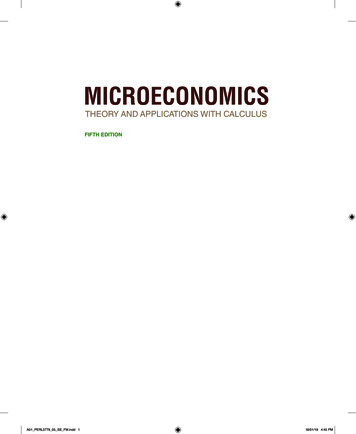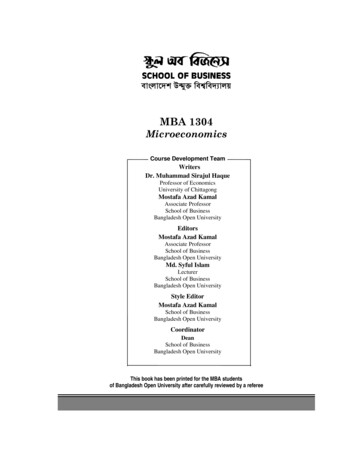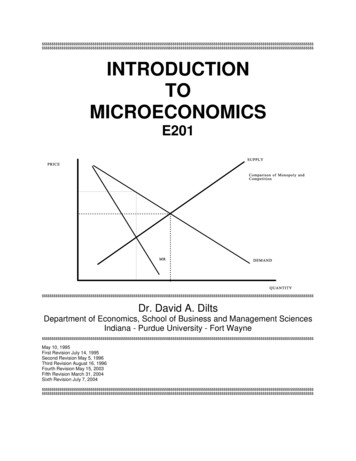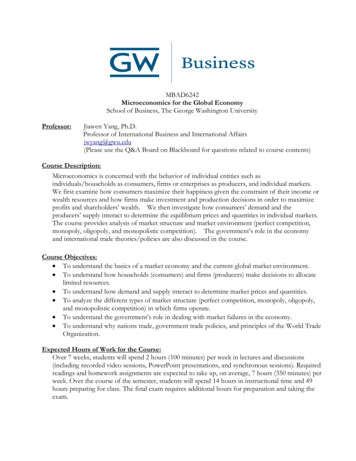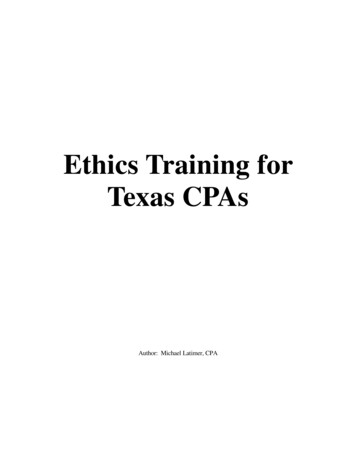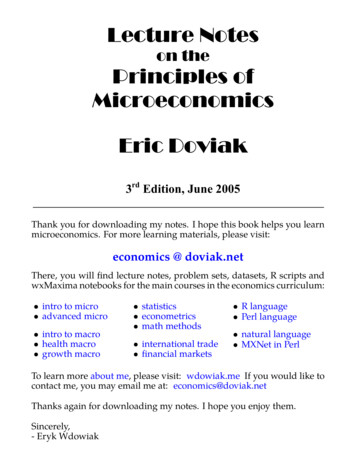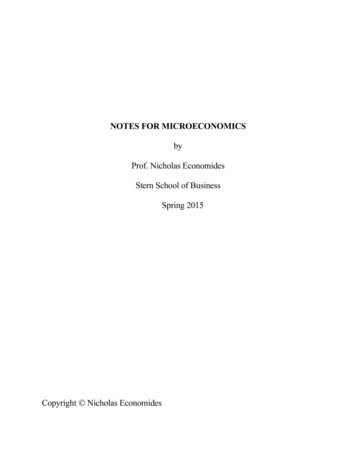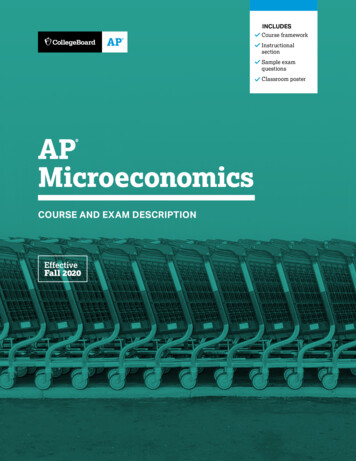
Transcription
INCLUDES Course framework Instructionalsection ample examSquestions Classroom posterAPMicroeconomics COURSE AND EXAM DESCRIPTIONEffectiveFall 2020
APMicroeconomics COURSE AND EXAM DESCRIPTIONEffectiveFall 2020AP COURSE AND EXAM DESCRIPTIONS ARE UPDATED PERIODICALLYPlease visit AP Central (apcentral.collegeboard.org) to determine whethera more recent course and exam description is available.
About College BoardCollege Board is a mission-driven not-for-profit organization that connectsstudents to college success and opportunity. Founded in 1900, College Boardwas created to expand access to higher education. Today, the membershipassociation is made up of over 6,000 of the world’s leading educational institutionsand is dedicated to promoting excellence and equity in education. Each year,College Board helps more than seven million students prepare for a successfultransition to college through programs and services in college readiness andcollege success—including the SAT and the Advanced Placement Program.The organization also serves the education community through research andadvocacy on behalf of students, educators, and schools.For further information, visit collegeboard.org.AP Equity and Access PolicyCollege Board strongly encourages educators to make equitable access a guidingprinciple for their AP programs by giving all willing and academically preparedstudents the opportunity to participate in AP. We encourage the eliminationof barriers that restrict access to AP for students from ethnic, racial, andsocioeconomic groups that have been traditionally underrepresented. Schoolsshould make every effort to ensure their AP classes reflect the diversity of theirstudent population. College Board also believes that all students should haveaccess to academically challenging coursework before they enroll in AP classes,which can prepare them for AP success. It is only through a commitment toequitable preparation and access that true equity and excellence can be achieved.Designers: Sonny Mui and Bill Tully 2020 College Board. College Board, Advanced Placement, AP, AP Central, and the acorn logo areregistered trademarks of College Board. All other products and services may be trademarks of theirrespective owners.Visit College Board on the web: collegeboard.org.
Contentsv Acknowledgments1 About AP4 AP Resources and Supports6 Instructional Model7 About the AP Microeconomics Course7 College Course Equivalent7 PrerequisitesCOURSE FRAMEWORK11 Introduction13 Course Framework Components15 Course Skills17 Course Content20 Course at a Glance23 Unit Guides25 Using the Unit Guides29 UNIT 1: Basic Economic Concepts41 UNIT 2: Supply and Demand57 UNIT 3: Production, Cost, and the Perfect Competition Model71 UNIT 4: Imperfect Competition83 UNIT 5: Factor Markets93 UNIT 6: Market Failure and the Role of GovernmentINSTRUCTIONAL APPROACHES107 Selecting and Using Course Materials108 Teaching the AP Economics Courses109 Instructional Strategies113 Developing Course SkillsEXAM INFORMATION121 Exam Overview126 Sample Exam QuestionsSCORING GUIDELINES137 Question 1: Long141 Question 2: ShortAPPENDIX145 AP Microeconomics Conceptual Framework165 AP Microeconomics Graphs and Visuals
THIS PAGE IS INTENTIONALLY LEFT BLANK.
AcknowledgmentsCollege Board would like to acknowledge the following committeemembers, consultants, and reviewers for their assistance with andcommitment to the development of this course. All individuals and theiraffiliations were current at the time of contribution.Nicholas Anello, Homewood-Flossmoor High School, Flossmoor, ILDavid Burgin, Science Hill High School, Johnson City, TNPeter Duffer, Buffalo Grove High School, Buffalo Grove, ILJoshua Hayes, St. George’s High School, Spokane, WAThomas Kinnaman, Bucknell University, Lewisburg, PAMary Kohelis, Weirton Madonna High School, Weirton, WVDee Mecham, The Bishop’s School, La Jolla, CALynda Motiram, Dulaney High School, Lutherville-Timonium, MDMatthew Pedlow, Chelsea High School, Chelsea, MIEsther Redmount, Colorado College, Colorado Springs, COMartha Rush, Mounds View High School, Arden Hills, MNPamela Schmitt, United States Naval Academy, Annapolis, MDPatrick Scholten, Bentley University, Waltham, MAPlease note that the course framework included in this document wasinspired by work originally undertaken by the AP MicroeconomicsCurriculum Development and Assessment Committee.College Board StaffElizabeth Healy, Director, AP Economics Content andInstructional DevelopmentDana Kopelman, Executive Director, AP Content Integration andChange ManagementDaniel McDonough, Senior Director, AP Content IntegrationAllison Milverton, Director, AP Curricular PublicationsAllison Thurber, Executive Director, AP Curriculum and AssessmentSPECIAL THANKS Christopher Budano and John R. WilliamsonAP Microeconomics Course and Exam Description V.1 vReturn to Table of Contents 2020 College Board
THIS PAGE IS INTENTIONALLY LEFT BLANK.
About APCollege Board’s Advanced Placement Program (AP )enables willing and academically prepared studentsto pursue college-level studies—with the opportunityto earn college credit, advanced placement, orboth—while still in high school. Through AP coursesin 38 subjects, each culminating in a challengingexam, students learn to think critically, construct solidarguments, and see many sides of an issue—skillsthat prepare them for college and beyond. TakingAP courses demonstrates to college admission officersthat students have sought the most challengingcurriculum available to them, and research indicatesthat students who score a 3 or higher on an AP Examtypically experience greater academic success incollege and are more likely to earn a college degreethan non-AP students. Each AP teacher’s syllabusis evaluated and approved by faculty from some ofthe nation’s leading colleges and universities, andAP Exams are developed and scored by college facultyand experienced AP teachers. Most four-year collegesand universities in the United States grant credit,advanced placement, or both on the basis of successfulAP Exam scores; more than 3,300 institutions worldwideannually receive AP scores.AP Course DevelopmentIn an ongoing effort to maintain alignment with bestpractices in college-level learning, AP courses andexams emphasize challenging, research-basedcurricula aligned with higher education expectations.Individual teachers are responsible for designing theirown curriculum for AP courses, selecting appropriatecollege-level readings, assignments, and resources.This course and exam description presents the contentand skills that are the focus of the correspondingcollege course and that appear on the AP Exam. It alsoorganizes the content and skills into a series of unitsthat represent a sequence found in widely adoptedcollege textbooks and that many AP teachers havetold us they follow in order to focus their instruction.The intention of this publication is to respect teachers’time and expertise by providing a roadmap that theycan modify and adapt to their local priorities andpreferences. Moreover, by organizing the AP coursecontent and skills into units, the AP Program is ableAP Microeconomics Course and Exam Descriptionto provide teachers and students with formativeassessments—Personal Progress Checks—thatteachers can assign throughout the year to measurestudent progress as they acquire content knowledgeand develop skills.Enrolling Students:Equity and AccessCollege Board strongly encourages educators tomake equitable access a guiding principle for theirAP programs by giving all willing and academicallyprepared students the opportunity to participatein AP. We encourage the elimination of barriersthat restrict access to AP for students from ethnic,racial, and socioeconomic groups that have beentraditionally underserved. College Board also believesthat all students should have access to academicallychallenging coursework before they enroll in AP classes,which can prepare them for AP success. It is onlythrough a commitment to equitable preparation andaccess that true equity and excellence can be achieved.Offering AP Courses:The AP Course AuditThe AP Program unequivocally supports the principlethat each school implements its own curriculum that willenable students to develop the content understandingsand skills described in the course framework.While the unit sequence represented in this publicationis optional, the AP Program does have a short list ofcurricular and resource requirements that must befulfilled before a school can label a course “AdvancedPlacement” or “AP.” Schools wishing to offer AP coursesmust participate in the AP Course Audit, a processthrough which AP teachers’ course materials arereviewed by college faculty. The AP Course Auditwas created to provide teachers and administratorswith clear guidelines on curricular and resourcerequirements for AP courses and to help colleges anduniversities validate courses marked “AP” on students’transcripts. This process ensures that AP teachers’courses meet or exceed the curricular and resourceexpectations that college and secondary school facultyhave established for college-level courses. V.1 1Return to Table of Contents 2020 College Board
The AP Course Audit form is submitted by theAP teacher and the school principal (or designatedadministrator) to confirm awareness and understandingof the curricular and resource requirements. A syllabusor course outline, detailing how course requirementsare met, is submitted by the AP teacher for review bycollege faculty.Please visit collegeboard.org/apcourseaudit for moreinformation to support the preparation and submissionof materials for the AP Course Audit.How the AP ProgramIs DevelopedThe scope of content for an AP course and exam isderived from an analysis of hundreds of syllabi andcourse offerings of colleges and universities. Usingthis research and data, a committee of college facultyand expert AP teachers work within the scope ofthe corresponding college course to articulate whatstudents should know and be able to do upon thecompletion of the AP course. The resulting courseframework is the heart of this course and examdescription and serves as a blueprint of the content andskills that can appear on an AP Exam.The AP Test Development Committees are responsiblefor developing each AP Exam, ensuring the examquestions are aligned to the course framework. TheAP Exam development process is a multiyear endeavor;all AP Exams undergo extensive review, revision,piloting, and analysis to ensure that questions areaccurate, fair, and valid, and that there is an appropriatespread of difficulty across the questions.Committee members are selected to represent a varietyof perspectives and institutions (public and private,small and large schools and colleges), and a range ofgender, racial/ethnic, and regional groups. A list of eachsubject’s current AP Test Development Committeemembers is available on apcentral.collegeboard.org.Throughout AP course and exam development,College Board gathers feedback from variousstakeholders in both secondary schools and highereducation institutions. This feedback is carefullyconsidered to ensure that AP courses and exams areable to provide students with a college-level learningexperience and the opportunity to demonstrate theirqualifications for advanced placement or college credit.How AP Exams Are ScoredThe exam scoring process, like the course and examdevelopment process, relies on the expertise of bothAP teachers and college faculty. While multiple-choicequestions are scored by machine, the free-responseAP Microeconomics Course and Exam Descriptionquestions and through-course performanceassessments, as applicable, are scored by thousandsof college faculty and expert AP teachers. Most arescored at the annual AP Reading, while a small portionis scored online. All AP Readers are thoroughly trained,and their work is monitored throughout the Readingfor fairness and consistency. In each subject, a highlyrespected college faculty member serves as ChiefFaculty Consultant and, with the help of AP Readersin leadership positions, maintains the accuracy ofthe scoring standards. Scores on the free-responsequestions and performance assessments are weightedand combined with the results of the computer-scoredmultiple-choice questions, and this raw score isconverted into a composite AP score on a 1–5 scale.AP Exams are not norm-referenced or graded on a curve.Instead, they are criterion-referenced, which means thatevery student who meets the criteria for an AP score of2, 3, 4, or 5 will receive that score, no matter how manystudents that is. The criteria for the number of pointsstudents must earn on the AP Exam to receive scoresof 3, 4, or 5—the scores that research consistentlyvalidates for credit and placement purposes—include:§§ The number of points successful college studentsearn when their professors administer AP Examquestions to them.§§ The number of points researchers have foundto be predictive that an AP student will succeedwhen placed into a subsequent higher-levelcollege course.§§ Achievement-level descriptions formulated bycollege faculty who review each AP Exam question.Using and Interpreting AP ScoresThe extensive work done by college faculty andAP teachers in the development of the course andexam and throughout the scoring process ensuresthat AP Exam scores accurately represent students’achievement in the equivalent college course. Frequentand regular research studies establish the validity ofAP scores as follows:AP ScoreCreditRecommendationCollege GradeEquivalent5Extremely well qualifiedA4Well qualifiedA-, B , B3QualifiedB-, C , C2Possibly qualifiedn/a1No recommendationn/a V.1 2Return to Table of Contents 2020 College Board
While colleges and universities are responsible forsetting their own credit and placement policies, mostprivate colleges and universities award credit and/or advanced placement for AP scores of 3 or higher.Additionally, most states in the U.S. have adoptedstatewide credit policies that ensure college creditfor scores of 3 or higher at public colleges anduniversities. To confirm a specific college’s AP credit/placement policy, a search engine is available atapstudent.org/creditpoliciesBECOMING AN AP READEREach June, thousands of AP teachers and collegefaculty members from around the world gather forseven days in multiple locations to evaluate andscore the free-response sections of the AP Exams.Ninety-eight percent of surveyed educators who tookpart in the AP Reading say it was a positive experience.There are many reasons to consider becoming anAP Reader, including opportunities to:§§ Bring positive changes to the classroom:Surveys show that the vast majority of returningAP Readers—both high school and collegeAP Microeconomics Course and Exam Descriptioneducators—make improvements to the way theyteach or score because of their experience at theAP Reading.§§ Gain in-depth understanding of AP Exam andAP scoring standards: AP Readers gain exposureto the quality and depth of the responses from theentire pool of AP Exam takers, and thus are betterable to assess their students’ work in the classroom.§§ Receive compensation: AP Readers arecompensated for their work during the Reading.Expenses, lodging, and meals are covered forReaders who travel.§§ Score from home: AP Readers have onlinedistributed scoring opportunities for certain subjects.Check collegeboard.org/apreading for details.§§ Earn Continuing Education Units (CEUs):AP Readers earn professional development hoursand CEUs that can be applied to PD requirementsby states, districts, and schools.How to ApplyVisit collegeboard.org/apreading for eligibilityrequirements and to start the application process. V.1 3Return to Table of Contents 2020 College Board
AP Resourcesand SupportsBy completing a simple activation process at the start of the school year, teachers andstudents receive access to a robust set of classroom resources.AP ClassroomAP Classroom is a dedicated online platform designed to support teachers and studentsthroughout their AP experience. The platform provides a variety of powerful resources andtools to provide yearlong support to teachers and enable students to receive meaningfulfeedback on their performance.UNIT GUIDESAppearing in this publication and on AP Classroom, these planning guides outline all requiredcourse content and skills, organized into commonly taught units. Each unit guide suggests asequence and pacing of content, scaffolds skill instruction across units, organizes contentinto topics, and provides tips on taking the AP Exam.PERSONAL PROGRESS CHECKSFormative AP questions for every unit provide feedback to students on the areas where theyneed to focus. Available online, Personal Progress Checks measure knowledge and skillsthrough multiple-choice questions with rationales to explain correct and incorrect answers,and free-response questions with scoring information. Because the Personal ProgressChecks are formative, the results of these assessments cannot be used to evaluate teachereffectiveness or assign letter grades to students, and any such misuses are grounds for losingschool authorization to offer AP courses.*PROGRESS DASHBOARDThis dashboard allows teachers to review class and individual student progress throughoutthe year. Teachers can view class trends and see where students struggle with content andskills that will be assessed on the AP Exam. Students can view their own progress over time toimprove their performance before the AP Exam.AP QUESTION BANKThis online library of real AP Exam questions provides teachers with secure questions to usein their classrooms. Teachers can find questions indexed by course topics and skills, createcustomized tests, and assign them online or on paper. These tests enable students to practiceand get feedback on each question.*To report misuses, please call, 877-274-6474 (International: 1-212-632-1781).AP Microeconomics Course and Exam Description V.1 4Return to Table of Contents 2020 College Board
Digital ActivationIn order to teach an AP class and make sure students are registered to take the AP Exam,teachers must first complete the digital activation process. Digital activation gives studentsand teachers access to resources and gathers students’ exam registration information online,eliminating most of the answer sheet bubbling that has added to testing time and fatigue.AP teachers and students begin by signing in to My AP and completing a simple activationprocess at the start of the school year, which provides access to all AP resources, includingAP Classroom.To complete digital activation:§§ Teachers and students sign in to or create their College Board accounts.§§ Teachers confirm that they have added the course they teach to their AP Course Auditaccount and have had it approved by their school’s administrator.§§ Teachers or AP Coordinators, depending on who the school has decided is responsible,set up class sections so students can access AP resources and have exams ordered ontheir behalf.§§ Students join class sections with a join code provided by their teacher or AP Coordinator.§§ Students will be asked for additional registration information upon joining their first classsection, which eliminates the need for extensive answer sheet bubbling on exam day.While the digital activation process takes a short time for teachers, students, andAP Coordinators to complete, overall it helps save time and provides the followingadditional benefits:§§ Access to AP resources and supports: Teachers have access to resources specificallydesigned to support instruction and provide feedback to students throughout the schoolyear as soon as activation is complete.§§ Streamlined exam ordering: AP Coordinators can create exam orders from the sameonline class rosters that enable students to access resources. The coordinator reviews,updates, and submits this information as the school’s exam order in the fall.§§ Student registration labels: For each student included in an exam order, schools willreceive a set of personalized AP ID registration labels, which replaces the AP student pack.The AP ID connects a student’s exam materials with the registration information theyprovided during digital activation, eliminating the need for pre-administration sessions andreducing time spent bubbling on exam day.§§ Targeted Instructional Planning Reports: AP teachers will get Instructional PlanningReports (IPRs) that include data on each of their class sections automatically rather thanrelying on special codes optionally bubbled in on exam day.AP Microeconomics Course and Exam Description V.1 5Return to Table of Contents 2020 College Board
InstructionalModelIntegrating AP resources throughout the course can help students develop skills andconceptual understandings. The instructional model outlined below shows possible ways toincorporate AP resources into the classroom.PlanTeachers may consider the following approaches as they plan their instruction beforeteaching each unit.§§ Review the overview at the start of each unit guide to identify essential questions,conceptual understandings, and skills for each unit.§§ Use the Unit at a Glance table to identify related topics that build toward a commonunderstanding, and then plan appropriate pacing for students.§§ Identify useful strategies in the Instructional Approaches section to help teach theconcepts and skills.TeachWhen teaching, supporting resources can be used to build students’ conceptualunderstanding and their mastery of skills.§§ Use the topic pages in the unit guides to identify the required content.§§ Integrate the content with a skill, considering any appropriate scaffolding.§§ Employ any of the instructional strategies previously identified.§§ Use the available resources on the topic pages to bring a variety of assets intothe classroom.AssessTeachers can measure student understanding of the content and skills covered in the unit andprovide actionable feedback to students.§§ At the end of each unit, use AP Classroom to assign students the online PersonalProgress Checks, as homework or as an in-class task.§§ Provide question-level feedback to students through answer rationales; provide unit- andskill-level feedback using the progress dashboard.§§ Create additional practice opportunities using the AP Question Bank and assign themthrough AP Classroom.AP Microeconomics Course and Exam Description V.1 6Return to Table of Contents 2020 College Board
About the APMicroeconomics CourseAP Microeconomics is a college-level course that introduces students to the principlesof economics that apply to the functions of individual economic decision-makers. Thecourse also develops students’ familiarity with the operation of product and factor markets,distributions of income, market failure, and the role of government in promoting greaterefficiency and equity in the economy. Students learn to use graphs, charts, and data toanalyze, describe, and explain economic concepts.College Course EquivalentAP Microeconomics is equivalent to a one-semester introductory college coursein economics.PrerequisitesThere are no prerequisites for AP Microeconomics. Students should be able to read acollege-level textbook and possess basic mathematics and graphing skills.AP Microeconomics Course and Exam Description V.1 7Return to Table of Contents 2020 College Board
THIS PAGE IS INTENTIONALLY LEFT BLANK.
AP MICROECONOMICSCourseFramework
IntroductionThe AP Microeconomics course outlined in this framework reflects acommitment to what economics teachers, professors, and researchershave agreed is the main goal of a college-level microeconomics course:to introduce students to the principles that apply to individual economicdecision-makers.The AP Microeconomics Course and Exam Descriptiondefines concepts, skills, and understandings requiredby representative colleges and universities for grantingcollege credit and placement. The course preparesstudents to think like economists by using principlesand models to describe economic situations and predictand explain outcomes. Like economists, students doso by using graphs, charts, and data.AP Microeconomics Course and Exam DescriptionAlthough the course framework is designed to providea clear and detailed description of the course contentand skills, it is not a curriculum. A college-level textbookthat covers the required course content should beused, and teachers create their own curricula to meetthe needs of their students and any state or localrequirements.Course Framework V.1 11Return to Table of Contents 2020 College Board
THIS PAGE IS INTENTIONALLY LEFT BLANK.
Course FrameworkComponentsOverviewThis course framework provides a clear and detailed description of the courserequirements necessary for student success.The course framework includestwo essential components:1COURSE SKILLSThe course skills are central to the study and practice of economics.Help students develop and apply the described skills on a regular basisover the span of the course.2COURSE CONTENTThe course content is organized into commonly taught units of studythat provide a suggested sequence for the course. These units comprisethe content and conceptual understandings that colleges and universitiestypically expect students to master to qualify for college credit and/orplacement. This content is grounded in big ideas, which are cross-cuttingconcepts that build conceptual understanding and spiral throughoutthe course.AP Microeconomics Course and Exam DescriptionCourse Framework V.1 13Return to Table of Contents 2020 College Board
THIS PAGE IS INTENTIONALLY LEFT BLANK.
1AP MICROECONOMICSCourseSkillsThe AP Economics skills describe what a student should be able to do whileexploring course concepts. The table that follows presents these skills, whichstudents should develop during the AP Microeconomics and AP Macroeconomicscourses. These skills form the basis of the tasks on the AP Exam.The unit guides later in this publication embed and spiral these skills throughoutthe course, providing teachers with one way to integrate the skills in the coursecontent with sufficient repetition to prepare students to transfer those skills whentaking the AP Exam. Course content may be paired with a variety of skills on theAP Exam.More detailed information about teaching the course skills can be found in theInstructional Approaches section of this publication.AP Microeconomics Course and Exam DescriptionCourse Framework V.1 15Return to Table of Contents 2020 College Board
AP MICROECONOMICSAP Economics SkillsSkill Category 1Skill Category 2Skill Category 3Skill Category 4Principles andModels 1InterpretationManipulationGraphing andVisuals 42Explain given economic outcomes.Define economic principles and models.3Determine outcomes of specificeconomic situations.Model economic situations usinggraphs or visual representations.SKILLS1.A Describe economicconcepts, principles,or models.1.B Identify an economicconcept, principle, or modelillustrated by an example.1.C Identify an economicconcept, principle, or modelusing quantitative dataor calculations.1.D Describe the similarities,differences, and limitationsof economic concepts,principles, or models.2.A Using economicconcepts, principles, ormodels, explain how aspecific economic outcomeoccurs or what action shouldbe taken in order to achieve aspecific economic outcome.2.B Using economicconcepts, principles, ormodels, explain how aspecific economic outcomeoccurs when there aremultiple contributingvariables or what multipleactions should be taken inorder to achieve a specificeconomic outcome.3.A Determine the outcomeof an economic situationusing economic concepts,principles, or models.4.A Draw an accuratelylabeled graph or visual torepresent an economicmodel or market.3.B Determine the effect(s)of one or more changes onother economic markets.4.B Demonstrate yourunderstanding of a specificeconomic situation on anaccurately labeled graphor visual.3.C Determine the effect(s)of a change in an economicsituation using quantitativedata or calculations.4.C Demonstrate the effectof a change in an economicsituation on an accuratelylabeled graph or visual.2.C Interpret a specificeconomic outcomeusing quantitative dataor calculations.AP Microeconomics Course and Exam DescriptionCourse Framework V.1 16Return to Table of Contents 2020 College Board
2AP MICROECONOMICSCourseContentBased on the Understanding by Design (Wiggins and McTighe) model, this courseframework provides a clear and detailed description of the course requirementsnecessary for student success. The framework specifies what students mustknow, be able to do, and understand, with a focus on big ideas that encompasscore principles and theories of the discipline. The framework also encouragesinstruction that prepares students for advanced economics coursework.Big IdeasThe big ideas serve as the foundation of the course and allow students to createmeaningful connections among concepts. They are often abstract concepts orthemes that become threads that run throughout the course. Revisiting the bigideas and applying them in a variety of contexts allows students to develop deeperconceptual understanding. Below are the big ideas of the course and a briefdescription of each:BIG IDEA 1: SCARCITY AND MARKETS (MKT)Limited resources and unlimited wants result in the need to make choices.In a market economy, the choices of buyers and sellers determine marketprices and the allocation of scarce resources.BIG IDEA 2: COSTS, BENEFITS, AND MARGINAL ANALYSIS (CBA)There are trade-offs associated with any decision. Making optimal decisionsrequires evaluating the additional costs and benefits of possible actions.BIG IDEA 3: PRODUCTION CHOICES AND BEHAVIOR (PRD)Firms seek to minimize costs and maximize profits, which influences theirproduction decisions in the
Microeconomics COURSE AND EXAM DESCRIPTION Effective Fall 2020 INCLUDES Course framework no al i t ucr t s In section Sample exam questions Classroom poster. AP COURSE AND EXAM DESCRIPTIONS ARE UPDATED PERIODICALLY Please visit AP

